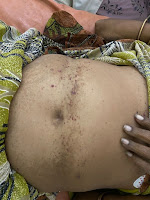Internal assesment 16/11/2020
https://medicinedepartment.blogspot.com/2020/11/-learning-bimonthly-
Internal assesment to the questions asked in the above blog spot.
First case:
1) "55 year old male patient came with the complaints of
Chest pain since 3 days
Abdominal distension since 3 days
Abdominal pain since 3 days and decreased urine output since 3days and not passed stools since 3days
https://sreejaboga.blogspot.com/2020/11/is-online-e-log-book-to-discuss-our.html?m=1
a) Where are the different anatomical locations of the patient's problems and what are the different etiologic possibilities for them? Please chart out the sequence of events timeline between the manifestations of each of these problems and current outcomes.
1)a)Anatomical :abdominal distension chest pain (epigastrium as mentioned in HOPI) suggests pancreas and or upper GIT
Decreased urine out put : kidneys
Pancreatitis causing severe pre renal AKI (Third space loss : in our patient third space loss is due to pancreatitis SIRS ) and if prolonged periods of pre renal azotemia is present it further progresses to Ischaemic injury : ATN
One is pancreatitis secondary to microlithiasis(gall stones) leading to ATN
and the other is Chronic renal failure leading to pancreatitis.
b) What are the pharmacological and non pharmacological interventions used in the management of this patient and what are the efficacy of each one of them?
1)b)Antibiotics as patient has sepsis (SIRS)
Tramadol to decrease pancreatic pain
Second case :
2) A 55 year old male, shepherd by occupation, presented to the OPD with the chief complaints of fever (on and off), loss of appetite, headache, body pains, generalized weakness since 2 months, cough since 2 weeks and vomitings and pain abdomen since 2 days.
https://aakansharaj.blogspot.com/2020/11/55-year-old-male-with-anemia.html?m=1
a) Where are the different anatomical locations of the patient's problems and what are the different etiologic possibilities for them? Please chart out the sequence of events timeline between the manifestations of each of these problems and current outcomes.
2)a) anemia with high gamma gap tells us it could be a chronic infectious or Plasma cell dycariasis or as there is target end organ damage ( renal failure anemia skull lytic lesions) it could be Multiple myeloma among plasma cell dyscariasis and lung pathology likely TB( apical and middle lobe involvement with constitutional symptoms being present) common in patients in immunocompromised state
Anatomical : Lung and plasma cells in bone marrow
b) What are the pharmacological and non pharmacological interventions used in the management of this patient and what are the efficacy of each one of them?
2)b) Augmentin and Azithromycin to cover respiratory infections
https://www.ncbi.nlm.nih.gov/pmc/articles/PMC3904367/ Thalidomide with dexa treatment is superior when compared to dexa with placebo in outcomes
Third case:
3) 51 Year old man with complaints of B/L pitting pedal edema from 5 to 6months,abdominal distension from 2 to 3 days,SOB from 3days.
nithishaavula.blogspot.com/2020/11/51-yr-old-male-with-hfref.html?m=1
a) Where are the different anatomical locations of the patient's problems and what are the different etiologic possibilities for them? Please chart out the sequence of events timeline between the manifestations of each of these problems and current outcomes.
3)a) Macrovascular complications of DM HTN ( Coronary cerebral arteries) both.
The adipokines release from the visceral fat causing atherosclerosis of the vessels resulting in unstable plaque formation resulting in thrombosis and hence MI leading to heart failure and CVA
Visceral fat accumulation rather than whole body adiposity has been implicated in the development of diabetes, lipid disorders, hypertension and astherosclerosis.72 Clinical studies suggest a strong association of visceral fat accumulation and liver steatosis in morbidly obese individuals.73 Notably, visceral fat accretion is also a “normal” phenomenon associated with ageing in humans.74 In contrast, caloric restriction (CR) potently protects against obesity, type 2 diabetes, hypertension, atherosclerosis and other ageing-associated metabolic diseases.75 Whereas insulin resistance usually accompanies obesity and is the basis for many associated co-morbidities,76 CR increases insulin sensitivity which is the potential underlying mechanism for beneficial effects of CR.77
https://www.ncbi.nlm.nih.gov/pmc/articles/PMC3075414/
b) What are the pharmacological and non pharmacological interventions used in the management of this patient and what are the efficacy of each one of them?
3)b) Metxl to control heart rate in HFrEF and enalapril acei inhibitor to reduce afterload and aspirin for secondary prevention of stroke and lasix to reduce preload
4) 31 yr old man with B/L pedal edema with scrotal and penile swelling since 2 months
https://nairaditya97.blogspot.com/2020/11/31-yr-old-male-with-bl-pedal-edema-with.html?m=1
a) Where are the different anatomical locations of the patient's problems and what are the different etiologic possibilities for them? Please chart out the sequence of events timeline between the manifestations of each of these problems and current outcomes.
4)a) Anatomical location : Sob and pedal edema with raised JVP due to increased hydrostatic pressure says heart failure


Comments
Post a Comment